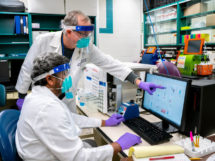

In 2013 aerospace manufactured products became the number one export in the Commonwealth of Kentucky as reported by the Kentucky Cabinet for Economic Development. The industry has skyrocketed to $10.8 billion in exports in 2017 and accounts for over 17,500 jobs in the commonwealth. Kentucky has become an aerospace state. The Space Science Center at Morehead State University has played a role in establishing aerospace as the number one industry in Kentucky through workforce development and through its contributions to research and development (R&D) in astronautics. In addition to producing graduates with exceptional skills to support the aerospace and defense workforce, Morehead State develops some of the world’s most cuttingedge satellite technology.
The Center specializes in micro and nanosatellites and has evolved into an internationally-recognized center for research in these “smallsat” technologies. These small satellites can range from the size of loaf of bread-size to a small suitcase and orbit Earth in formations. They are being used by NASA, the DoD and private aerospace companies for a variety of applications ranging from Earth remote sensing to astrophysics and planetary science research. Smallsats are considered “disruptive technology” by the aerospace industry because they can provide some of the same services as conventional satellites at a fraction of the cost and with short development times. Morehead State University is at the forefront of this emerging technology.
Taking advantage of increased access to space made possible by new rocket companies like Space X, Morehead State faculty and students have built and launched six satellites to Earth orbit since 2006 (KySat-2, CXBN, Eagle-1, Eagle-2, UniSat-5, and CXBN-2) with a major mission currently under development (Lunar IceCube). These missions have ranged from technology demonstrations to astrophysics research and have been very successful, gaining international attention. The technology developed at Morehead State has attracted aerospace and telecommunications companies to spin off subsidiaries in Eastern Kentucky and has also inspired small aerospace start-ups to locate in those regions.
To support the aerospace industry, Morehead State built the Space Science Center in 2009 with state-of-the art laboratories that includes the infrastructure required to develop a variety of nanosatellite technologies. Entire spacecraft are now built under one roof- the concept and design, fabrication, testing and mission operations all take place at Morehead State. After being launched on NASA, European or Russian rockets, students and staff at the Space Science command the spacecraft and downlink data and telemetry using the Center’s 21 meter deep space ground station. The 21 meter antenna system has been funded by NASA to become the first non-NASA node on the NASA Deep Space Network dedicated to providing ground operation services for interplanetary smallsat missions. Having the highly specialized research infrastructure has contributed to the Center’s success. Strategic partnerships with NASA Centers (JPL, Goddard Spaceflight Center, and Marshall Spaceflight Center), the aerospace industry (Honeywell Space and Defense, the Busek Space Propulsion Company, Rajant and others), other universities (MIT, CalPoly, UofL and KCTCS) and international partners (University of Rome, GAUSS, the Keldysh Institute of Applied Mathematics) have also led to the development of key enabling technologies.
Perhaps the most exciting mission undertaken by the Space Science Center is Lunar IceCube, a NASA mission that was selected for launch on Exploration Mission One (EM-1), the maiden voyage of NASA’s new heavy rocket – the Space Launch System (SLS). When SLS launches in 2019, it will be the most powerful rocket ever built. Morehead State leads the $20 million mission in partnership with NASA Goddard Spaceflight Center, JPL, and the Busek Space Propulsion Company, who will send an orbiting 14 kg probe on a circuitous route to the Moon where it will orbit for a year and investigate the transportation physics of water ice on the Lunar surface in support of a lunar outpost that NASA plans to develop. These interplanetary CubeSats will likely open the door to a new era of space exploration with interplanetary small satellite systems. Morehead State’s Lunar IceCube is among these path-finding missions.
In addition, to the R&D efforts, the Center offers several innovative degree programs, a B.S. in Space Science (a unique hybrid science-engineering technology program that trains students for careers in space technologies and applications), an M.S. in Space Systems Engineering and a B.S. in Astrophysics. The B.S. in Space Science is a unique degree program – one of only 5 in the nation at the undergraduate level – it is a hybrid astronautical engineering/space science program whose graduates are highly sought after in the space industry. Graduates of these programs are working at NASA Centers, in government laboratories and in the aerospace and defense industries all across the United States.
With the Lunar IceCube mission well underway, several other smallsat missions in planning phases and with Morehead State becoming the interplanetary smallsat node on NASA’s Deep Space network, the future is looking up for aerospace at Morehead State University and in Kentucky.




















Add Comment